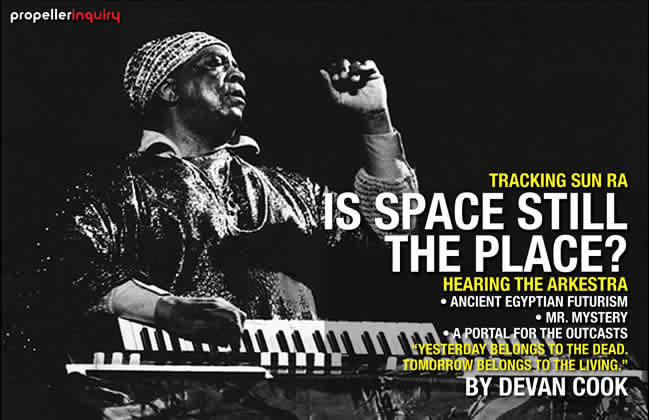
from the April 2011 issue
A GROUP OF about twenty African American musicians stand on a rooftop, creating a dizzying array of sound with their various instruments. The horn section plays wildly, saxophones hitting notes that sound abnormally high. Behind the horns, bongo drums are beaten in erratic counts, while someone to the side clinks and clanks on a xylophone. Acoustic and electric guitars emit no recognizable rhythm, their players humming along without any synchronicity. Some might call this “free jazz,” but the music is truly impossible to categorize. Each performer is adorned in brightly colored costumes that incorporate elements of ancient Egyptian garb into a 1970’s interpretation of futuristic attire. The music comes to a pause as a female vocalist with a sparkly red cape and blue mask half sings, half chants, “When the world was darkness / and darkness was ignorance / along came Ra.”
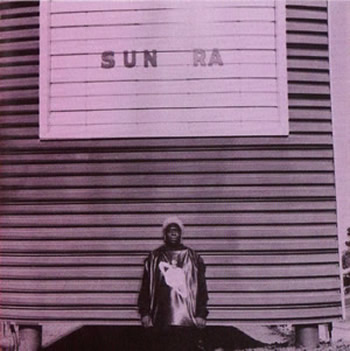 The rooftop performance is documented in Robert Mugge’s film A Joyful Noise. The 1980 documentary provides an in-depth look at Sun Ra and his Arkestra (a purposeful misspelling of the word Orchestra). Ra was known for holding a tight rein over his collective of musicians, making the Arkestra practice anywhere from eight to twelve hours a day in a house in New York City’s East Village. In an effort to combat high rent, as well as to establish their unity as an artist collective, the musicians lived together. The house would eventually become Sun Studios, where Ra and the Arkestra self-recorded and produced their own albums through Ra’s label, Saturn Records. When they weren’t practicing or recording, Ra spent part of each day teaching the Arkestra his philosophy on the limitations of life on earth, as well as extolling the opportunities that lie in outer space.
The rooftop performance is documented in Robert Mugge’s film A Joyful Noise. The 1980 documentary provides an in-depth look at Sun Ra and his Arkestra (a purposeful misspelling of the word Orchestra). Ra was known for holding a tight rein over his collective of musicians, making the Arkestra practice anywhere from eight to twelve hours a day in a house in New York City’s East Village. In an effort to combat high rent, as well as to establish their unity as an artist collective, the musicians lived together. The house would eventually become Sun Studios, where Ra and the Arkestra self-recorded and produced their own albums through Ra’s label, Saturn Records. When they weren’t practicing or recording, Ra spent part of each day teaching the Arkestra his philosophy on the limitations of life on earth, as well as extolling the opportunities that lie in outer space.
“Planet Earth can’t even be sufficient without the rain, it doesn’t produce rain, you know,” Ra coolly states in A Joyful Noise’s opening monologue. “Sunshine…it doesn’t produce the sun. The wind, it doesn’t produce the wind. All planet Earth produces is the dead bodies of humanity. That’s its only creation. Everything else comes from outer space…Humanity’s life depends on the unknown. Knowledge is…laughable when attributed to a human being.”
With no narration, Mugge’s documentary lets Sun Ra, members of his Arkestra, and his music do the talking. Scenes of Ra walking around an Egyptian exhibit while philosophizing in a stream-of-conscious manner are alternately fascinating and exhausting. When Ra looks into the camera and says, “I’m not part of history, I’m more a part of the mystery,” there’s an eye-rolling moment for any audience that can’t help but wonder if it’s wasting sixty minutes watching the ramblings of a madman. But a few minutes later, an extended live performance at a nightclub shows Ra in his element: leading the Arkestra while playing keyboard, his music communicates his message with a clarity his vernacular distorted. How does a man who embraces such extremes come into being?
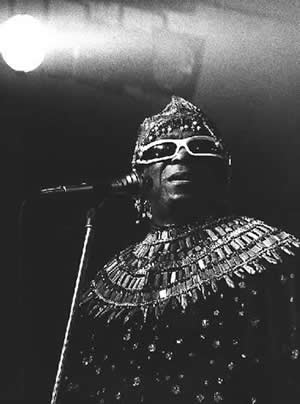 “I have many names; some call me Mr. Ra, others call me Mr. Re, you can call me Mr. Mystery.” —Sun Ra, from A Joyful Noise
“I have many names; some call me Mr. Ra, others call me Mr. Re, you can call me Mr. Mystery.” —Sun Ra, from A Joyful Noise
THERE IS MUCH uncertainty surrounding the early years of Herman Poole Blount; many of the facts of his birth and childhood were skewed by Sun Ra himself. Most blatantly, Ra insisted he was not of this earth. In Space Is the Place: The Lives and Times of Sun Ra, John F. Szwed recounted his older sister Mary’s assertion that her brother was born in Alabama. “He was born at my [great] aunt’s house…I know, ’cause I got on my knees and peeped through the keyhole. He’s not from no Mars.” Szwed’s biography quotes Ra as saying, “It is important for the planet that its inhabitants do not believe in being born, because whoever is born is to die.”
Family members recall Blount as being an excellent student, but having little to no friends. In 1936, Ra was attending the Alabama State Agricultural & Mechanical Institute for Negroes (“I think I studied everything at the school except farming,” Ra said) and becoming increasingly withdrawn from his peers. He was spending countless hours at the library researching religions when he had his great epiphany. As he described it, two men from space brought him with them to Saturn, to inform him that “there was going to be great trouble in schools,” and that he should not continue with his education. They told Ra that when the world was going into complete chaos, then and only then would he speak, and the world would listen. Upon his return to earth, Ra discontinued his education, and realized the voice in which to deliver his message was his music. Music would serve as the portal between earth and space, a bridge to galaxies where humankind—specifically the black population—could seek opportunities they were not given on this planet.
His years playing music in Chicago from 1945-60 were marked by a more accessible big-band sound that started evolving into bop. His interest in space, and pushing the limits of earthly sounds, had already begun to develop. Ra claimed to have bought one of the first Wurlitzer electric pianos in the late fifties, using the keyboard to deconstruct his formal musical education, and to reassemble various sounds and chord progressions in unconventional ways. In that early Chicago period, however, his spacey textures were met with sharp cynicism, and while early records such as “Sun Song” hint at innovation, the big-band sound is most apparent.
![]()
By the time Ra and some key members of the Arkestra found themselves in New York in 1960, Ra was fully immersed in an uncategorized sound. By recording and cutting his own albums, he was generally free to do as he pleased, and his experimentation in the early sixties with free jazz, psychedelic sounds, and a musical operation that had Ra strictly supervising a group of hand-picked musicians in his home resembled a mixture of—and made him a predecessor to—Miles Davis, Andy Warhol, and Frank Zappa. Throughout the sixties, Ra cut more records each year than most artists complete in a lifetime, the only thing limiting his production being financial restraints. From writing, composing, and playing on the records, to producing them and even hand-painting many of the album covers, Ra controlled every element of the recording process. Finding musicians that not only understood his vision, but were willing to sacrifice their social life in order to be ready for Ra’s spontaneous and frequent calls to the studio wasn’t easy. But for key members of his Arkestra like Danny Thompson, Elo Omoe, and James Jacson, there was no other option.
“Sometimes it’s tough,” Omoe acknowledges in A Joyful Noise. “[You miss out on] the pleasures of going out to enjoy yourself because you gotta stay to rehearse, but once you get into the music you forget all about the other thing that was happening because the music got you so into it that the rest of it don’t even matter.”
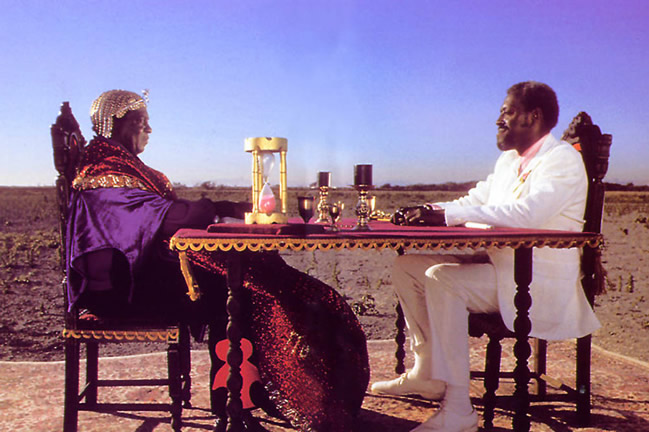
“The one that made the best leader was the one who did the most outlandish thing; the thing that was not normal. Something no one else had thought to do.” —James Jacson
FILM PRODUCER Jim Newman approached Sun Ra in the early seventies about making a half-hour documentary of the Arkestra for PBS, and, in true Sun Ra fashion, a simple documentary soon turned into a science-fiction/blaxploitation/narrative-with-documentary-elements/feature-length film. Space Is the Place saw a limited release in New York and San Francisco in 1974, as did the accompanying soundtrack of the same name. The film’s storyline begins with Ra returning to earth (Oakland, to be specific) after visiting a distant planet. Ra expresses his desire to relocate the black population of America to this other world, using music as the portal. His main obstacle in achieving this goal is “The Overseer,” a pimp with supernatural powers who currently controls the black population with drugs, sexual temptation, and indifference. Ra faces off against the Overseer in a series of duels, and eventually beats him when, at the end of the film, Ra conducts a concert to spread his message. But the surreal film and its convoluted plot failed to impress a mainstream audience, and it was pulled just a couple showings after its release.
Dissatisfied with the treatment of African Americans in the United States, Ra sought to create a new future for the black population, and felt this future awaited in space. Ra often referred to blacks as being “myths,” saying that they were not treated as humans, and therefore the white population was denying their existence. If they were already thought of as myths, why shouldn’t they then actually become myths—people not of this planet? (This is what led to Ra’s denial of his own birth, which he re-spelled as “berth” meaning “to be earthed.”) He compared slaves’ experiences of being brought from Africa to America to an alien abduction. To be transported by a ship against one’s will, to a foreign territory where no one speaks your language and treats you as if you don’t belong once you get there, in Ra’s mind was not much different from being taken into space. America had failed to accept this foreign population, but space provided another opportunity.
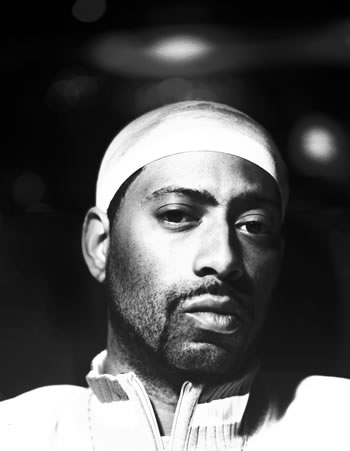 “Yesterday belongs to the dead. Tomorrow belongs to the living.” —Madlib, from the song “Shadows of Tomorrow”
“Yesterday belongs to the dead. Tomorrow belongs to the living.” —Madlib, from the song “Shadows of Tomorrow”
WHILE COUNTLESS artists have listed Sun Ra as an influence, perhaps the closest embodiment of his musical ambition is rapper/producer/multi-instrumentalist Madlib. The musician—who gives a nod to Sun Ra in several of his songs—walks that fine line between abundant and excessive as he, like Ra, has produced, written, and/or performed on over a hundred albums. Whereas Ra worked with his Arkestra, Madlib generally works alone, creating multiple monikers to record under. For his jazz albums recorded as Yesterday’s New Quintet, Madlib went so as far as to create fake biographies for each “member,” when in actuality his “Arkestra” is made up of five Madlibs. Madvillainy, the debut album from Madvillain, another of his projects, features a tribute to Sun Ra titled “Shadows of Tomorrow.” The hip hop track features excerpts from Space Is The Place, with rappers Madlib and MF Doom lyricizing Ra philosophy, and even has Madlib repeating “Sun Ra” over and over. The title of the song is taken from a song Ra wrote titled “The Shadows Cast By Tomorrow” that was released on a limited 7-inch, hand-painted by Ra. “Earth is cool,” Madlib has said, “but I’m interested in what’s beyond Earth.” In the spirit of his predecessor, Madlib claims to be part-alien, and speaks coolly about music in a way that stretches beyond earthly restraint.
In a generation where many sounds and musical genres are being recycled from days long past, be it the current wave of 60s garage-rock revival or the slew of Joy Division sound-a-likes, one can’t help but wonder why more artists aren’t looking forward instead of backward. Ra pioneered a sound that extended beyond what was known on Earth during his time, but space is a vast place, and he left the door open to many uncharted territories. Ra understood that earth isn’t diverse enough for everyone. With his nearly two hundred albums, he did his part to provide a portal for the outcasts of this planet, the myths: those who think differently, and perhaps don’t quite belong here. Although he departed this earth on May 30, 1993, let us not speak of Sun Ra in the past tense, but rather look to him in the future. For, as he puts it in A Joyful Noise, “They say that history repeats itself, but history is only his story. You haven’t heard my story yet.” Ω
Devan Cook is a freelance writer for Willamette Week, and former sports journalist for the Portland Trail Blazers.











